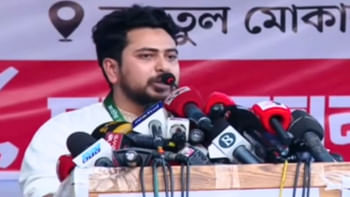From bricks to walls: Women torchbearers

“One of our favourite pastimes was to gather with our friends on the rooftops and practice broto-chari...with the daily laundry strung as 'tents' off course,” my mother would tell us whenever the women's movement came up in the conversation. Here they learnt the simple dance and songs which led the way to Bratachari Movement, initiated by Gurushodoi Dutta.
With so many forces barring women's freedom, this was the only acceptable compromise. Little did anyone know how these simple routines would slowly evolve and inspire women to emerge from their age-old confines. Dr. Nurun Nahar Fyzennessa (my mother), had been at the forefront of the women's movement for over 50 years and I believed her when she said that the greatest changes could start from something seemingly insignificant.
The brotochari dance encouraged patriotism, secularism and most importantly physical and psychological fitness amongst the youth. Progressive families championed the spirit of education and culture among girls. A handful of girls who were emboldened with such opportunities soon stepped into the world beyond their courtyard. This was the beginning and soon the time would come when that step would take women on to the stage of performing arts, in essence the very core of society.
The radio of course played a significant role. After the 1947 partition, the first radio station was on Nazimuddin Road in old Dhaka, the then city centre. Perhaps, out of sight of viewers, the radio was the most attractive channel for women to perform for the audience and yet maintain their privacy.
Vocalists Afsari Khanam, Anjali Mukherjee, Malika Perveen were joined by legendary voices of Feroza Begum and Laila Arjumand Banu. The golden era of music in erstwhile East Pakistan (during 1955-60) was led by Ferdousi Begum, Anjuman Ara Begum, Mahbuba Rahman, Farida Yasmeen, Nina Hamid, Sanjida Khatun and Farida Bari Malik to name a few. After Liberation War, the momentum was nurtured by a host of talented artists from Sabina Yasmeen, Shahnaz Rahmatullah, Runa Laila, to Papya Sarwar, Nilufar Yasmeen, Shabnam Mushtari, Rezwana Chowdhury, Farida Parveen and more.
The theatre world was not far behind. I often heard stories from my mother about how very few women initially joined the drama circle when she herself entered the scene along with Madhobi Chatterjee, Nomita Anwar, Lilly Chowdhury, Biju Mustafa and much later Ayesha Khanam, Mirana Zaman and others. In films Sultana Zaman, Reshma, Sujata, Sumita Devi, Shabnam, Rosy and later Kabori, Babita, Shuchanda also joined in gradually.
Then there was Khelaghar, an immensely popular radio programme aimed at nurturing the budding talents way back in the mid '60s. Shahnaz Rahmatullah, Sabina Yasmeen, Shaheen Samad, Sabiha Mahbub, Abida Sultana and myself appeared almost every Sunday, then the weekly holiday. Children gathered from all around the city to sing or recite a few lines from poems. Dr. Fyzennessa initially conducted the programme and after a decade, Hena Kabir took over.
Over the years, some of the leading dancers to grace the stage were Rahiza Khanam, Laila Hasan, Sharmin Hasan, Dahlia Salauddin, Kajol Ibrahim, Lubna Marium, Zeenat Barkatullah, Shamim Ara Nipa, Munmun Ahmed and others.
The changing role of women progressed slowly from the makeshift tents on rooftops, to centre stage to public media -- growing from strength to strength. Change needs a face, and these spirited artistes leave a lasting image of the women's movement. Let us take a moment to honour women everywhere, not only as a part of today's agenda, but to treasure them as role models who inspire many.

 For all latest news, follow The Daily Star's Google News channel.
For all latest news, follow The Daily Star's Google News channel. 



Comments